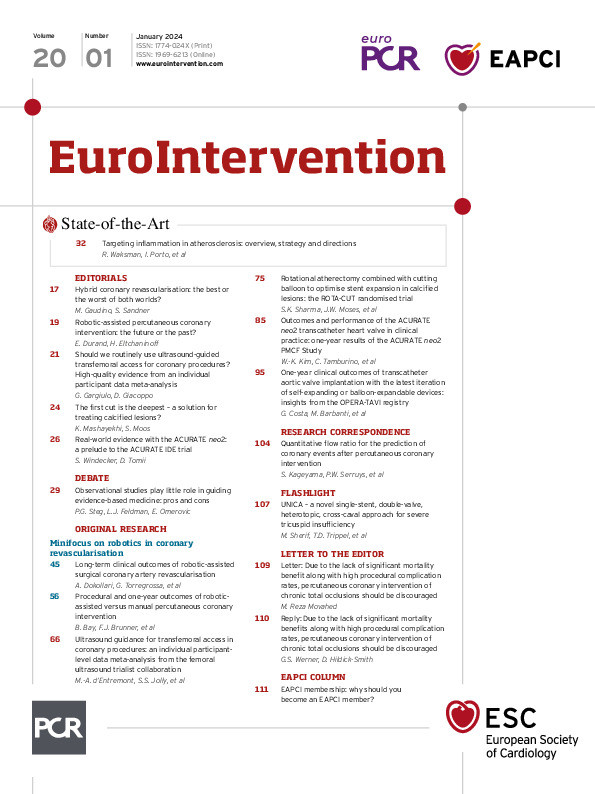Robotics is a rapidly growing field in medicine, particularly in certain surgical disciplines. The use of robotics in interventional cardiology is relatively recent. The first robot to carry out coronary interventions was developed in 2012 by Corindus Vascular Robotics Inc., using first- (CorPath 200 system; Corindus) and second-generation (CorPath GRX; Corindus) devices. In 2019, the company was acquired by Siemens, but in May 2023, faced with a disappointing uptake in cardiology, Siemens announced a shift to neurovascular interventions.
Previous studies reported the safety and feasibility of robotic-assisted percutaneous coronary intervention (PCI), first in simple lesions, then in more complex lesions, and showed a dramatic reduction in radiation exposure for the primary operator12. In a retrospective propensity score matching study, it was shown that robotic PCI was associated with a significant reduction in patient exposure to radiation, no increase in fluoroscopy time or contrast use, and a minor increase in procedural duration compared with traditional PCI3. Furthermore, case reports or small series have demonstrated the feasibility of robotic PCI in more complex lesions, including unprotected left main lesions, true bifurcations, and chronic total occlusions. More recently, the European multicentre prospective R-EVOLUTION study demonstrated the safety and feasibility of another robotic-assisted PCI device, the R-One (Robocath)4.
In this issue of EuroIntervention, Bay et al have reported the procedural and one-year outcomes of robotic-assisted PCI using the second-generation CorPath GRX vascular robotic system, compared with manual PCI, in patients with chronic coronary syndrome and non-ST-elevation myocardial infarction acute coronary syndrome. Propensity score matching of 70 patients who underwent robotic PCI with 210 patients who underwent manual PCI was performed. The population was well balanced, with similar coronary artery disease severity in the two groups. Robotic PCI was associated with longer fluoroscopy times and similar contrast fluid volume, compared to manual PCI. The one-year follow-up reports a similar incidence of mortality and major adverse cardiovascular events in the two groups. Of note, manual assistance and manual conversion were required in 25.9% and 5.9% of robotic PCI, respectively5.
Robotic-assisted PCI therefore appears to be an attractive solution, allowing for, on the one hand, a considerable reduction in the exposure of operators to X-rays and, on the other hand, millimetre precision in manoeuvering wires and devices, with the potential to improve procedural and clinical outcomes for patients. Repeated exposure to fluoroscopic radiation puts interventionalists and staff at risk, with well-known health consequences including DNA damage and cancer. Orthopaedic complications from the long-term use of heavy lead aprons are also common, resulting in lost workdays and decreased performance. Notwithstanding, robotic-assisted PCI remains poorly adopted worldwide in our catheterisation laboratories. What are the reasons for this? First, current robotic PCI systems have a number of limitations. Manual vascular access and engagement of the coronary artery with the guiding catheter are still necessary. Furthermore, these devices allow manipulation of only one coronary guidewire at a time with the simultaneous positioning of only one balloon or stent. Anatomical or lesion characteristics requiring planned use of any over-the-wire device (e.g., microcatheter, atherectomy) cannot be performed robotically. However, these technical limitations could likely be addressed in future generations of robotic-assisted systems. Second, all the published data included only prospective or retrospective registries, and these have only demonstrated non-inferiority, in terms of safety and feasibility, of robotic-assisted PCI compared to conventional manual angioplasty, although a reduction in longitudinal geographical miss was also reported6. To our knowledge, no randomised studies have compared robotic-assisted and manual PCI. In other words, we still don’t know the main advantages of robotic PCI compared to manual PCI. Most of the studies demonstrated a significant reduction in radiation exposure for the first operator but did not address the issue of exposure for the second operator (who inserts and retrieves the wire, balloon or stent). Third, studies with a current-generation robot reported a high incidence of manual assistance or conversion, particularly in complex lesions235. Again, future generations of robotic-assisted systems should address this issue by reducing the incidence of manual assistance or conversion. Fourth, all the studies reported a significantly longer duration of robotic-assisted PCI compared with manual PCI, which implies a slowdown in workflow23. Finally, and importantly, the cost of acquiring a robotic-assisted system and the price of sterile single-use equipment (cassettes) may also be a barrier to the uptake of robotic-assisted PCI. Medico-economic studies are thus necessary to demonstrate the benefit of robotic-assisted PCI for both the patient and the operator.
In conclusion, we believe that robotic-assisted PCI is still relevant to reduce radiation exposure and to improve our treatment of complex coronary artery lesions. The end of the development and marketing of robotic-assisted devices for PCI by Siemens is, however, a bad sign. We are confident that continued research and development in this area will lead to a refinement and expansion of this technology in the future, as it has done in the field of surgical robotics.
Conflict of interest statement
The authors have no conflicts of interest to declare.

